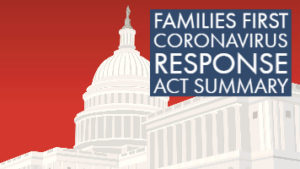On the evening of March 18, 2020, President Trump signed into law the Families First Coronavirus Response Act.
The law will go into effect on April 1, 2020. Employers must be prepared to comply with the law at that time. The Families First Coronavirus Response Act bolsters unemployment insurance; mandated group health plans, health insurers, and government programs to provide free Coronavirus testing; and boosted food assistance and federal funding for Medicaid. It also creates two new employer obligations to provide employees with leave. Below is a summary of these two new obligations.
Emergency FMLA Expansion
Employers with 499 or less employees must provide up to 12 weeks of job protected leave to eligible employees. Employees are eligible if they have been employed with the employer for at least 30 calendar days before leave begins.
Employees can take the leave if they are unable to work (or telework) due to the need to care for a minor child if the child’s school and/or place of care has closed due to a declared emergency from Federal, State, or local authorities related to COVID-19.
Here’s how it will work:
The first 10 days of the leave may be unpaid.
Employees can choose to use other accrued paid leave for these 10 days, but employers cannot require they do so.
After that, leave must be paid as follows:
- Two thirds (2/3) of the employee’s regular rate of pay will be paid for the number of hours the employee would otherwise be normally scheduled to work.
- If an employee has a variable schedule, then two thirds (2/3) of the employee’s regular rate of pay should be paid for the number of hours the employee was scheduled to work per day over the 6 month period preceding leave (including any hours the employee had taken leave).
- If an employee has not been with the employer for the past 6 months, but still qualifies for the leave, then two thirds (2/3) of their regular rate of pay should be paid for an average number of hours that were conveyed at the time of hire.
In no event should this paid leave exceed $200 per day and $10,000 in the aggregate.
Job protection
The FMLA’s existing job restoration requirements generally apply. There is some limited flexibility for employers with fewer than 25 employees who experience financial difficulties related to the COVID-19 public health emergency and cannot return the employee to the same or equivalent position after engaging in reasonable efforts.
Emergency Paid Sick Leave
Employers with 499 employees or less must provide paid sick time to employees who are unable to work (or telework) for any of the following reasons:
The employee…
- Is subject to Federal, State, or local quarantine or isolation
- Has been advised by a health care provider to self-quarantine
- Experiencing symptoms of Covid-19 and seeking a medical diagnosis
- Caring for an individual who is subject to Federal, State, or local quarantine or isolation and/or who has been advised by a health care provider to self-quarantine
- Caring for a minor child if their school or childcare provider is closed due to COVID-19 precautions
- Experiencing any other substantially similar condition specified by the Secretary of Health and Human Services in consultation with the Secretary of the Treasury and the Secretary of Labor.
Amount of leave
Employers are obligated to allow 80 hours of emergency paid sick leave for full-time employees. Part-time employees are entitled to emergency paid sick leave for the number of hours they average in a 2-week period.
Pay rate of leave
For leave taken for reasons 1-3 above, it should be paid at the employee’s regular rate subject to a maximum of $511 per day and $5,110 in the aggregate.
For leave taken for reasons 4-6 above, it should be paid at 2/3 the employee’s regular rate subject to a maximum of $200 per day and $2,000 in the aggregate.
Posting
Employers must post a notice, distributed by the Secretary of Labor, detailing this leave on or before April 1, 2020.
Anti-retaliation/anti-discrimination
An employer may not discharge, discipline or discriminate against any employee who takes leave under the Act or files any complaint or proceeding related to the Act.
Other rules of note
- This leave will not carry over into next year.
- Any leave not used at the time of an employee’s termination, resignation, or retirement does not need to be paid out to the employee.
- This leave is in addition to any existing employer-paid sick leave policies.
- The leave is available for use immediately on the effective date of the new law (April 2, 2020).
- Employees are entitled to use this leave first. An employer cannot force an employee to use other forms of paid leave before the emergency paid sick leave.
- Right now, both of these laws expire on December 31, 2020. Additional laws and regulations may be forthcoming.

